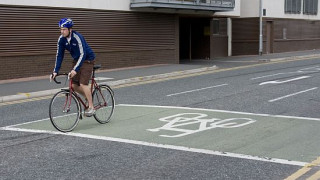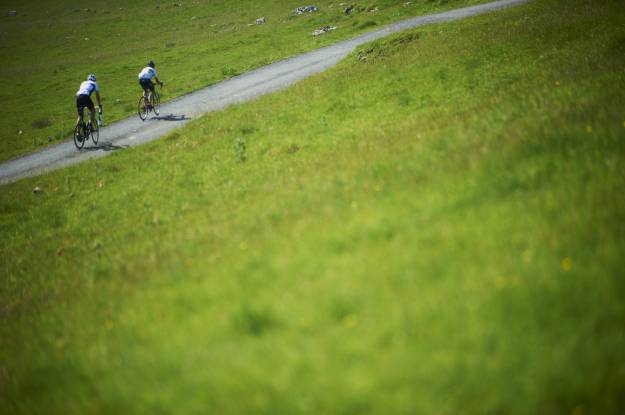Bitesize Bikeability: Part 3: Communication
Posted: 16th April 2010 | Source: British Cycling Cycle Training
Bikeability is Cycling Proficiency for the 21st century, teaching the skills to ride confidently and safely on today's roads. In this series of articles we'll look at some of the key concepts introduced on a Bikeability course, and show you some of the resources used on our National Standard Instructor Training Courses. These articles are not intended to replace Bikeability training, but hopefully will give you a taste of what might be covered on a course.
How to Communicate with Other Road Users
Why should cyclists communicate? We're not driving a car and we're not going to hurt anyone so why bother signaling? You're better off keeping your hands on the bars surely?
Above: Clear road positioning communicates the intention to turn right
Whilst you could argue that the last point has an element of truth to it there are plenty of good reasons to communicate, and in doing so improve both your safety, the safety of other road users, and improve the image of cyclists as responsible road users.
Who are we communicating with?
Before you think about how to communicate it's worth thinking about who you are communicating with- if there's nothing to communicate with you can save doing it!
|
Urban Cyclists |
Rural Cyclists
|
|
Drivers- cars, buses, HGV's etc |
Drivers
|
|
Motorbikes and Scooters |
Motorbikes
|
|
Pedestrians- likely to cross into the riders path |
Pedestrians- likely to be walking in the road
|
|
Other cyclists |
Other cyclists
|
|
|
Other users e.g. horse riders
|
How can we communicate?
Most people would probably be aware that they should use hand signals before turning a corner, just as a car should use it's indicators, but there are several other important ways you can communicate which suit different uses:
|
Method |
Communicate With |
Effective Range/Use |
|
Hand Signal |
All road users |
Prior to turning at a junction- relevant only for other users nearby
|
|
Point at Road |
Motor Vehicles, Other Cyclists |
Users immediately behind/next to you- show where you intend to move to on the road
|
|
Eye Contact |
All road users |
Close range- check someone has seen you and is aware of your intentions
|
|
Road Position |
All road users
|
Close range- be predictable- ride in the position a car would be in e.g. where lanes change
|
|
Verbal/Bell |
Cyclists, Pedestrians
|
Close range- useful method, especially for people not looking at you
|
Common Mistakes
-
Even experienced cyclists make some common and easily avoided mistakes with regard to communication on the road. Here's some things to avoid, we guarantee you do at least one of these currently!
Above: Good, positive hand signals clearly show the rider's intent - Signaling whilst turning a corner- when you're turning you definitely want both hands on the bars covering your brakes. Stop signaling in plenty of time to prepare to turn.
- Not Signaling to Pedestrians- a collision with a pedestrian crossing into your path can be painful for both parties. Either a verbal warning, ringing your bell or a hand signal can alert pedestrians to your intentions. Also consider controlling your speed and be ready to stop suddenly.
- Not Looking Before Signaling- if you don't look around how do you know who you're signaling to? Check first, and if there's nobody to signal to don't bother!
Top Tips
-
Eye Contact- helps make sure people have seen you, and informs people that you are alert and in control of the situation.
Above: Eye contact informs other road users that you are alert and in control of the situation. - Signal Early- give yourself plenty of time to perform a turn by signaling early. Hold a hand signal for roughly a count of 3 (try counting 3 elephants in your head).
- Be Clear- whether ringing a bell, making eye contact or giving a hand signal- make it clear and directed.
More Information
The best way to improve your on road cycling skills is through completing a Bikeability course. These are available free to most young people through schools, and in certain areas training for adults is also free.
To find your local Bikeability scheme visit www.bikeability.org.uk
If you would like to train as a Cycle Training Instructor to deliver Bikeability courses more information on British Cycling's Instructor courses is available here.
If there is an on road skill you'd like us to look at in more detail in a future article please contact cycletraining@britishcycling.org.uk with your suggestions.









